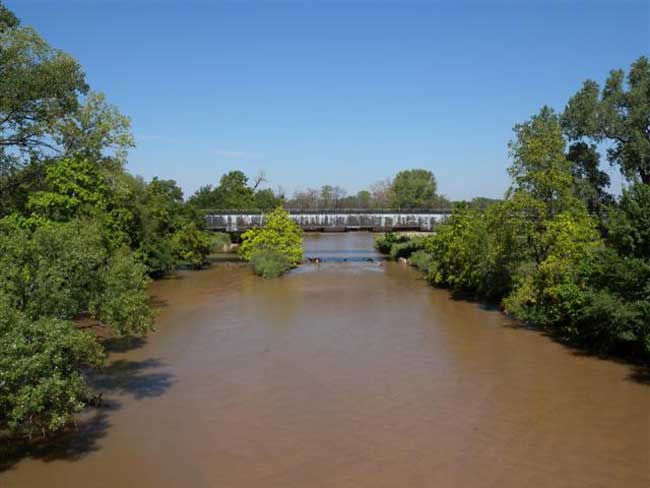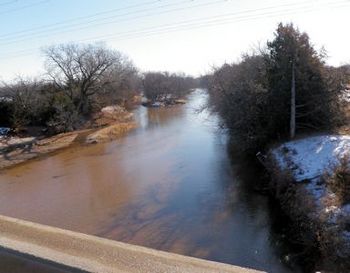
The Crimson Thread of History: Navigating the Medicine Lodge River’s Enduring Legacy
The Red Hills of Barber County, Kansas, are a landscape painted in fiery hues, a striking contrast to the emerald greens of the prairie. Here, under an immense sky that seems to stretch into eternity, a modest waterway carves its path, etching not just geological features but also an indelible mark on American history. This is the Medicine Lodge River, a name that evokes whispers of sacred ceremonies, grand councils, and the solemn weight of treaties forged and broken. More than just a stream winding through gypsum bluffs, the Medicine Lodge River is a living testament to the collision of cultures, the raw beauty of the plains, and the enduring spirit of a land steeped in profound narratives.
From its genesis in Kiowa County, the river flows southeastward, eventually merging with the Salt Fork of the Arkansas River. Its journey is relatively short, but every bend, every ripple, tells a story. The distinctive crimson soil, a result of iron oxides in the Permian-age red beds, gives the landscape an almost otherworldly appearance. These unique geological formations, sculpted by millennia of wind and water, are punctuated by dramatic gypsum outcroppings – "glass rocks" as they are sometimes called – that shimmer under the Kansas sun. This is a land of stark beauty, where the ruggedness of the terrain belies a delicate ecosystem supporting a surprising array of wildlife, from white-tailed deer and wild turkeys to the occasional bobcat.
The very name, Medicine Lodge, is a direct link to the river’s pre-Columbian significance. For centuries, various Native American tribes, including the Comanche, Kiowa, Cheyenne, Arapaho, Apache, and Wichita, revered this area. The river’s waters, often flowing over beds of gypsum, were believed to possess healing properties. The surrounding caves and bluffs offered shelter, and the abundant game made it a vital hunting ground. It became a sacred gathering place, a neutral territory where different tribes would come together for councils, spiritual ceremonies, and to harvest the mineral-rich waters and clays for medicinal purposes. The "medicine lodge" itself referred to the ceremonial structures, often temporary, erected near the river for these spiritual gatherings. It was a place of peace, healing, and profound cultural exchange long before the arrival of European settlers.

However, the river’s most significant chapter in recorded history unfolded in October 1867. By this time, the post-Civil War era had ushered in an accelerated westward expansion, and with it, escalating conflicts between white settlers, railroad companies, and the indigenous peoples whose lands were being encroached upon. The U.S. government, seeking to establish a lasting peace and clear the way for further settlement, convened one of the largest and most ambitious peace councils ever held between the federal government and Plains tribes. The chosen site for this monumental gathering was the banks of the Medicine Lodge River.
Thousands of people converged on the valley. On one side stood the U.S. Peace Commission, comprising prominent figures like Senator John B. Henderson, General William S. Harney, and Samuel F. Tappan, tasked with negotiating treaties. On the other, a formidable assembly of Native American leaders represented the collective will of their people: Satanta (White Bear) and Kicking Bird of the Kiowa; Black Kettle and Little Raven of the Southern Cheyenne and Arapaho; and Ten Bears and Quanah Parker of the Comanche. The atmosphere was a complex tapestry of hope, suspicion, and cultural misunderstanding.
For nearly two weeks, negotiations unfolded under the open sky. Speeches were delivered, gifts exchanged, and ceremonial pipes smoked. The Native American leaders eloquently articulated their deep spiritual connection to the land and their profound grief over the destruction of the buffalo herds, their primary sustenance. Satanta, a powerful Kiowa orator, famously declared, "I love the land and the buffalo and will not part with it. I want to live as I have lived… I do not want to settle down to a new way of life." His words encapsulated the heart of the resistance to forced assimilation.
Despite these powerful pleas, the treaties ultimately signed at Medicine Lodge were a reflection of the U.S. government’s predetermined agenda. The "Treaty of Medicine Lodge Creek" (often referred to as the Medicine Lodge Treaty) comprised three separate agreements with the Kiowa and Comanche; the Plains Apache; and the Cheyenne and Arapaho. In exchange for annuities, provisions, and the promise of education, the tribes agreed to relinquish vast tracts of their ancestral hunting grounds and settle on much smaller reservations in Indian Territory (present-day Oklahoma). The U.S. commissioners believed they had secured a lasting peace, but the reality was far more complex and tragic.
The ink on the treaties was barely dry before their promises began to unravel. The U.S. government often failed to deliver the promised annuities and supplies, leaving the tribes in desperate circumstances. Settlers continued to invade reservation lands, and the relentless slaughter of the buffalo by hide hunters decimated the very foundation of the Plains tribes’ way of life. Within a few short years, the fragile peace shattered, leading to renewed conflicts, including the Red River War, and ultimately, the complete subjugation and forced removal of the tribes to their designated reservations. The Medicine Lodge Treaty, while an attempt at peace, largely served as a legal pretext for the final dispossession of the Plains Indians.
Today, the Medicine Lodge River flows much as it did centuries ago, a silent witness to the ebb and flow of history. Its current meanders through a landscape shaped by both nature and human endeavor. The red earth that once felt the thundering hooves of bison now supports vast fields of wheat, milo, and alfalfa. The town of Medicine Lodge, founded in 1874, thrives nearby, its economy historically bolstered by agriculture and the mining of gypsum, which is used in plaster, drywall, and cement. The river remains a vital source of water for irrigation and a habitat for local wildlife, providing a crucial artery in this semi-arid region.
Yet, the legacy of 1867 is not forgotten. Every autumn, the town of Medicine Lodge hosts the Peace Treaty Pageant, a massive historical reenactment that draws thousands of visitors. This outdoor spectacle, first staged in 1927 and held every three to five years, brings the dramatic events of the treaty council to life. Locals and descendants of the original treaty participants gather to portray the chiefs, soldiers, commissioners, and families who were present. It’s a vibrant, living memorial, a way for the community to acknowledge and educate about this pivotal moment.
"The Pageant is more than just a show; it’s a profound act of remembrance and reconciliation," says local historian and pageant volunteer, Sarah Jenkins. "We strive for authenticity, not just in costumes and dialogue, but in conveying the immense human stakes involved. It’s a powerful experience to see the children of today’s Comanche, Kiowa, and Cheyenne nations standing on the same ground where their ancestors made such momentous decisions." Indeed, the participation of tribal members adds a layer of depth and authenticity, transforming the event from mere entertainment into a shared act of cultural memory and dialogue.

Beyond the pageant, the river itself continues to exert a subtle but persistent influence. Its unique ecology, characterized by the gypsum-rich soils and intermittent flows, supports specific plant communities, including various grasses, cottonwoods, and willows that cling to its banks. Conservation efforts in the region often focus on maintaining water quality, managing agricultural runoff, and preserving the delicate balance of the prairie ecosystem that still thrives in pockets along the river’s course. The Red Hills themselves are recognized for their unique biodiversity, a testament to the resilience of nature in the face of change.
The Medicine Lodge River, then, is a multifaceted entity. It is a geological marvel, its crimson bluffs and gypsum veins telling tales of ancient seas. It is an ecological haven, providing life and sustenance in a sometimes harsh land. But above all, it is a historical landmark, a silent sentinel that has witnessed some of the most consequential moments in the shaping of the American West. Its waters have reflected the hopes of peace, the despair of broken promises, and the enduring spirit of both indigenous peoples and pioneering settlers.
As one stands on its banks today, listening to the gentle murmur of its current and gazing out at the vast, unchanging sky, it’s impossible not to feel the weight of its history. The Medicine Lodge River is not just a geographical feature; it is a living narrative, a crimson thread woven through the tapestry of time, reminding us that even the smallest streams can carry the deepest currents of human experience. It is a place where history flows, continuously shaping our understanding of the land, its people, and the complex, often challenging, journey towards a shared future.


